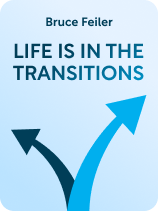

This article is an excerpt from the Shortform book guide to "Life Is in the Transitions" by Bruce Feiler. Shortform has the world's best summaries and analyses of books you should be reading.
Like this article? Sign up for a free trial here.
Want to know how to embrace change? How can you decide your next steps after a life change?
Bruce Feiler, the author of Life Is in the Transitions, says that life changes are difficult because you’re required to find a new way of being. He discusses three things you can do to figure out your next steps.
Here’s a look at Feiler’s advice for embracing life changes.
Explore New Ways of Being
Bruce Feiler explains that one of the most difficult parts of navigating how to embrace change is deciding your next steps. In the wake of a transformation, your old habits and beliefs no longer fit—so you need to let them die. In some cases, you might welcome this—for example, if you have a health crisis that forces you to stop smoking, you could feel eager to make the change and grateful for the wake-up call. In other cases, letting go of some aspects of your former self can be hard. For example, if you took a pay cut upon accepting a new job, you might struggle to adjust your spending habits. Regardless, Feiler says it’s important to let go of the habits and beliefs that no longer serve you—then, you can replace them with new ones that align with your current reality.
(Shortform note: One reason transformations require you to give up old habits and beliefs in favor of new ones could be that transformations create cognitive dissonance. Cognitive dissonance refers to the mental discomfort that happens when you hold conflicting beliefs, values, or behaviors. A transformative experience could create cognitive dissonance by introducing new information or circumstances that conflict with your existing beliefs or habits. For example, if you’ve always believed that your career defines your worth, losing your job could create dissonance between this belief and your new unemployed status. To resolve this discomfort, you might need to update your views about work and worth or get a new job.)
You need to find new ways to fill your days and discover what feels meaningful to you now, but developing new habits and beliefs isn’t always easy. The approach you start with just after a life change may not be the one you stick with, and Feiler says that’s OK. What’s important is that you give yourself opportunities to experiment with potential paths forward.
(Shortform note: In Awaken Your Genius, Ozan Varol argues that experimenting with potential paths forward is key to lasting happiness. If you’re too rigid in your approach to dealing with life changes, you may box yourself into a limited range of options and miss out on opportunities for growth and fulfillment. In contrast, embracing flexibility and experimentation can help you discover what truly resonates with you and lead to a more satisfying and meaningful life.)
Feiler explains that you can approach the challenge of figuring out your next steps in one of three ways—by embracing structure, embracing chaos, or seeking wisdom.
Embrace Structure
Feiler says that if you know (or think you know) what you want to do next, you can take steps to pursue it right away. For example, you might enroll in a personal training program to become healthier.
(Shortform note: You may find it helpful to embrace structure if you’re prone to decision fatigue—the tendency to become overwhelmed or paralyzed when faced with too many choices. Implementing a structured plan can streamline your decision-making process by providing clear goals and actionable steps. For instance, if you aim to improve your health, enrolling in a personal training program can offer a well-defined path and reduce the cognitive load associated with making numerous decisions about how to get started.)
Embrace Chaos
If you’re not sure of your next steps, Feiler says you can explore a variety of potential interests and activities to see what resonates with you. For example, you may dabble in different hobbies, attend various workshops, and volunteer for diverse causes.
(Shortform note: In The Pathless Path, Paul Millerd describes how embracing chaos helped him transition from an unfulfilling career in finance to a freelancing career that allowed him to build a life he truly loved. When he quit his 9-5, he bounced around Europe for five weeks while he explored a variety of freelance options, and he explains that his willingness to experiment and welcome uncertainty opened doors he wouldn’t have thought possible. However, it’s worth noting that Millerd had hefty financial resources at his disposal—depending on your financial limitations and comfort with uncertainty, you may need to embrace a muted form of chaos. For example, you may only be able to afford exploring one new hobby at a time.)
Seek Wisdom
If neither of the above options sounds appealing, Feiler suggests that you turn to personal reflection or seek wisdom from others before determining your next steps. For example, you could take up a contemplative practice like tai chi that gives you opportunities to look inward, or you could work with a spiritual advisor or life coach to clarify your values.
(Shortform note: Feiler proposes two sources of wisdom: yourself and others. How do you know which to seek out? If you feel comfortable with introspection and enjoy self-guided exploration, personal reflection through practices like tai chi, meditation, or journaling might be effective. But if self-reflection makes you feel anxious or if you’re prone to rumination (unhelpful wallowing in negative thoughts), you may find it more helpful to work with a spiritual advisor, life coach, or mentor who can provide guidance on your situation.)

———End of Preview———
Like what you just read? Read the rest of the world's best book summary and analysis of Bruce Feiler's "Life Is in the Transitions" at Shortform.
Here's what you'll find in our full Life Is in the Transitions summary:
- How to deal with curveballs and obstacles in life
- The pattern that most of life’s disruptions follow
- How to rewrite your life story in a positive way






